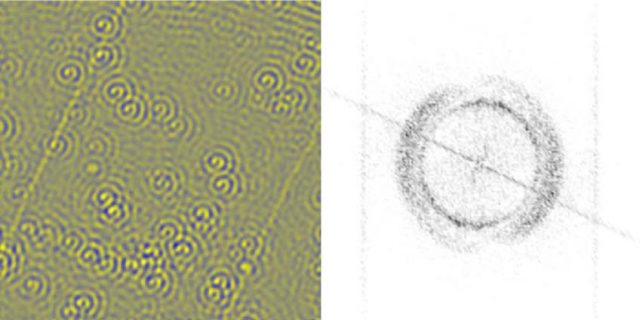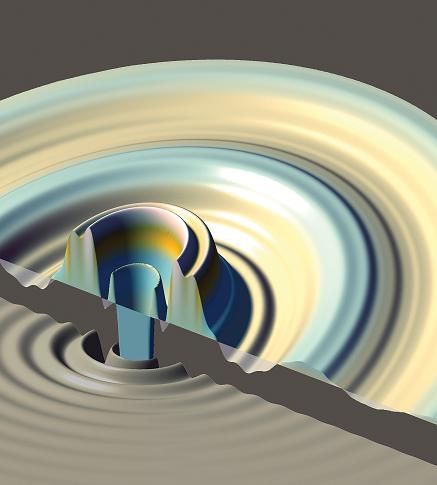Visualizing charge oscillations on a metal surface

With “many-body problem” we usually make reference to one that is very difficult to obtain exact solutions for, because the system involves interactions between more than two bodies. This kind of problem appears both in classical and quantum systems.
In order to understand the physics of many-body systems, it is necessary to make use of approximation techniques or model systems that capture the essential physics of the problem. Besides statistical methods, in quantum theory some useful concepts are introduced to better picture the system under study, like quasiparticles (a single-particle excitation which is modified by its interaction with the medium) or collective excitations (a quantized mode occurring because of the collective motion of the particles of the whole system). An example of collective excitation is the plasmon: the quantized oscillations of electrons.
Many-body effects and their influence on quantum coherence are known to be relevant in several exciting areas of condensed matter physics, such as superconductivity and quantum information, where they give rise to remarkable macroscopic properties. However, these effects are usually challenging to measure, especially with spatial resolution. Consequently, using a local probe to visualize them would greatly help to the understanding of important unconventional physical properties on a microscopic scale.
And this is exactly what a group of researchers from the University of Würtzburg and DIPC has achieved1. By imaging energy-dependent, standing-wave patterns at noble metal surfaces they reveal the existence of an ‘anomalous’ energy band with a well-defined dispersion. Its origin is related to the a kind of surface plasmon. Visualizing the corresponding charge oscillations provides thus direct access to many-body interactions at the atomic scale. The results are published in Nature Communications.

K. Pohl, B. Diaconescu, G. Vercelli, L. Vattuone, V. M. Silkin, E. V. Chulkov, P. M. Echenique and M. Rocca (2010) Acoustic surface plasmon on Cu(111) EPL 90, 57006
Interference is a general phenomenon that appears whenever we are dealing with the superposition of coherent waves. Because of the wave-particle duality, electrons can interfere. The invention of the scanning tunnelling microscope (STM) allowed the visualization of this effect by looking at the spectacular standing wave patterns produced by elastic scattering of electrons and holes at surface defects: vacancies, adsorbates, impurities or step edges, to name a few. These waves are known as Friedel oscillations and can be interpreted as quasi-particle interferences (QPI).
The Fermi energy is the maximum energy occupied by an electron at 0K. By the Pauli exclusion principle, we know that the electrons will fill all available energy levels, and the top of that “Fermi sea” of electrons is called the Fermi energy or Fermi level. Using STM measurements, the researchers were able to visualize how the Fermi sea locally rearranges to minimize the perturbation created by low-energy excitations.
By analysing the QPI patterns produced around point defects at Cu, Ag and Au (111) surfaces, they found evidence that the two-dimensional electron gas of the surface of the metals exhibits an additional contribution to the electronic local density oscillations, which leads to extra modulations in the QPI and are related to the acoustic surface plasmon, a novel collective electronic excitation at metal surfaces that has a linear (or acoustic-like) dispersion.
The team also concludes that the secondary electrons and holes incoherently produced during the inelastic decay process of an injected quasiparticle can contribute to the formation of QPI patterns as well. These secondary quasiparticles generate self-interfering patterns, which are cumulated to form the background contribution.
This findings expand the capabilities of QPI mapping as an experimental technique to study many-body effects in condensed matter physics, and could contribute to better understand superconductivity and quantum information problems.
Author: César Tomé López is a science writer and the editor of Mapping Ignorance.
References
- Paolo Sessi, Vyacheslav M. Silkin, Ilya A. Nechaev, Thomas Bathon, Lydia El-Kareh, Evgueni V. Chulkov, Pedro M. Echenique & Matthias Bode (2015) Direct observation of many-body charge density oscillations in a two-dimensional electron gas Nature Communications DOI: 10.1038/ncomms9691 ↩
1 comment
[…] Visualizing charge oscillations on a metal surface […]